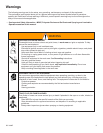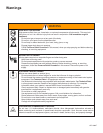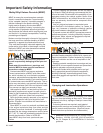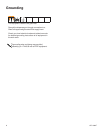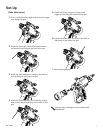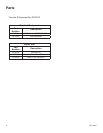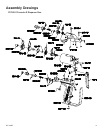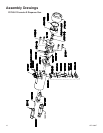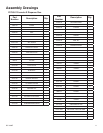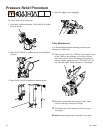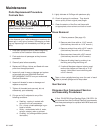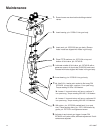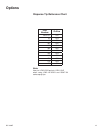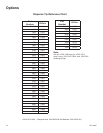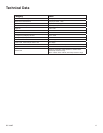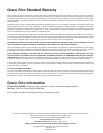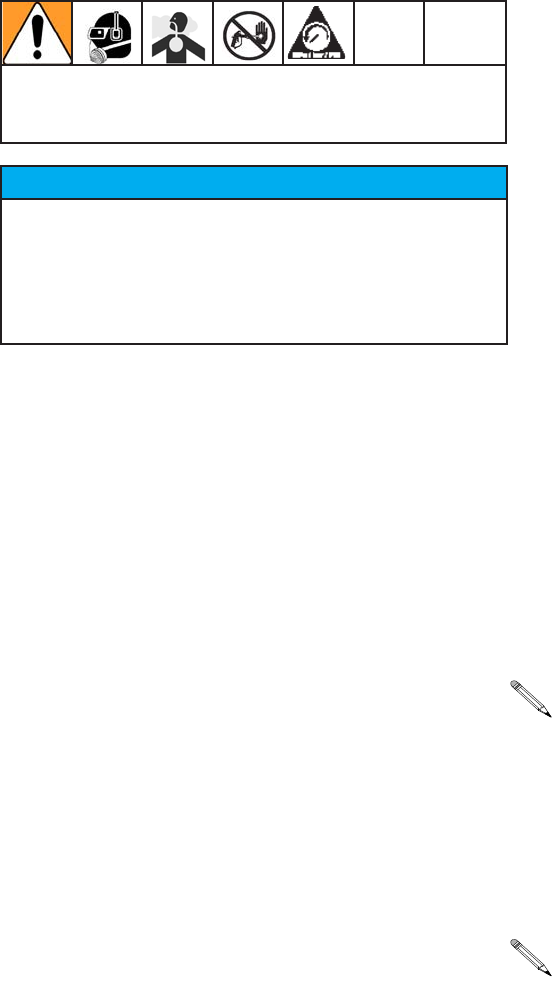
13GC-1393F
Parts Replacement Procedure
Formula Gun
Before performing maintenance on the dispense gun,
follow Pressure Relief Procedure.
Due to the different o-ring materials and lubricants used
in the dispense guns, never submerge or soak any dis-
pense gun in any type of solvent. Submerging or soak-
ing any dispense gun will immediately void the gun war-
ranty.
1. Read each procedure entirely before beginning
and refer to the illustration views as needed.
2. Flush and clean all passages as they become
accessible.
3. Clean all parts before assembly.
4. Replace all O-Rings, Valves and Seals with new
parts from the appropriate kit.
5. Inspect all parts for wear or damage and replace
as required with new GENUINE GlasCraft
REPLACEMENT PARTS from your authorized
GlasCraft Distributor.
6. Inspect all threads for wear or damage and
replace as required.
7. Tighten all threaded parts securely, but not
excessively, upon assembly.
8. O-rings can fail if subjected to any of the
following conditions.
a. Swelling - coming in contact with
solvent or oil from compressor.
b. Cut - sharp, unlubricated edge in gun
head or handle.
c. Sticky - contaminated with oil, water,
solvent, catalyst, resin or gel-coat.
d. Chafng - dry sliding surfaces (needs
lubrication).
9. Lightly lubricate all O-Rings with petroleum jelly.
10. Check all springs for resilience. They should
return quickly to their original (new) length.
11. Clean the exterior of the Gun and Hoses with
an appropriate, clean solvent and cloth or brush.
Hose Removal
1. Releive pressure (See page 19).
2. Remove resin Hose with an 11/16” wrench.
(Hold delivery tube with an 11/16” wrench.)
3. Remove catalyst Hose with a 9/16” wrench.
(Hold delivery tube with a 9/16” wrench.)
4. Remove solvent hose with a 5/8” wrench.
(Hold delivery tube with a 9/16” wrench)
5. Remove all tubing lines by pushing in on
the tting and pulling the tubing out.
6. If optional berglass chopper is being used,
remove the chopper air hose with a 11/16”
wrench. (Hold the air hose inlet tting with
a 9/16” wrench)
Tape a clean polyethylene bag over the end of each
Hose to prevent spillage and to keep clean.
Gun Service
Dispense Gun Component Service
and Assembly Procedures
If Seal, P/N 23763-00 and Packing Disks, P/N 23721-04
are removed from the Gun Body GlasCraft recommends
that these parts always be replaced with NEW seals and
packing disks.
Maintenance
Notice
Isocyanate Conditions
Rev. G 6/17/2008 21
Isocyanate Conditions
Material Self-ignition
Moisture Sensitivity of
Isocyanites
Isocyanites (ISO) are catalysts used in two component
foam and polyurea coatings. ISO will react with moisture
(such as humidity) to form small, hard, abrasive crystals,
which become suspended in the fluid. Eventually a film
will form on the surface and the ISO will begin to gel,
increasing in viscosity. If used, this partially cured ISO
will reduce performance and the life of all wetted parts.
To prevent exposing ISO to moisture:
• Always use a sealed container with a desiccant
dryer in the vent, or a nitrogen atmosphere. Never
store ISO in an open container.
• Keep the ISO lube pump reservoir (if installed) filled
with Graco Throat Seal Liquid (TSL), Part 206995.
The lubricant creates a barrier between the ISO and
the atmosphere.
• Use moisture-proof hoses specifically designed for
ISO, such as those supplied with your system.
• Never use reclaimed solvents, which may contain
moisture. Always keep solvent containers closed
when not in use.
• Never use solvent on one side if it has been contam-
inated from the other side.
• Always lubricate threaded parts with ISO pump oil
or grease when reassembling.
Keep Components A and
B Separate
Foam Resins with 245 fa
Blowing Agents
Some foam blowing agents will froth at temperatures
above 90°F (33°C) when not under pressure, especially
if agitated. To reduce frothing, minimize preheating in a
circulation system.
Spraying materials containing isocyanates creates
potentially harmful mists, vapors, and atomized partic-
ulates.
Read material manufacturer’s warnings and material
MSDS to know specific hazards and precautions
related to isocyanates.
Prevent inhalation of isocyanate mists, vapors, and
atomized particulates by providing sufficient ventila-
tion in the work area. If sufficient ventilation is not
available, a supplied-air respirator is required for
everyone in the work area.
To prevent contact with isocyanates, appropriate per-
sonal protective equipment, including chemically
impermeable gloves, boots, aprons, and goggles, is
also required for everyone in the work area.
Some materials may become self-igniting if applied
too thickly. Read material manufacturer’s warnings
and material MSDS.
The amount of film formation and rate of crystalli-
zation varies depending on the blend of ISO, the
humidity, and the temperature.
NOTICE
To prevent cross-contamination of the equipment’s
wetted parts, never interchange component A (isocy-
anate) and component B (resin) parts.
Isocyanate Conditions
Rev. G 6/17/2008 21
Isocyanate Conditions
Material Self-ignition
Moisture Sensitivity of
Isocyanites
Isocyanites (ISO) are catalysts used in two component
foam and polyurea coatings. ISO will react with moisture
(such as humidity) to form small, hard, abrasive crystals,
which become suspended in the fluid. Eventually a film
will form on the surface and the ISO will begin to gel,
increasing in viscosity. If used, this partially cured ISO
will reduce performance and the life of all wetted parts.
To prevent exposing ISO to moisture:
• Always use a sealed container with a desiccant
dryer in the vent, or a nitrogen atmosphere. Never
store ISO in an open container.
• Keep the ISO lube pump reservoir (if installed) filled
with Graco Throat Seal Liquid (TSL), Part 206995.
The lubricant creates a barrier between the ISO and
the atmosphere.
• Use moisture-proof hoses specifically designed for
ISO, such as those supplied with your system.
• Never use reclaimed solvents, which may contain
moisture. Always keep solvent containers closed
when not in use.
• Never use solvent on one side if it has been contam-
inated from the other side.
• Always lubricate threaded parts with ISO pump oil
or grease when reassembling.
Keep Components A and
B Separate
Foam Resins with 245 fa
Blowing Agents
Some foam blowing agents will froth at temperatures
above 90°F (33°C) when not under pressure, especially
if agitated. To reduce frothing, minimize preheating in a
circulation system.
Spraying materials containing isocyanates creates
potentially harmful mists, vapors, and atomized partic-
ulates.
Read material manufacturer’s warnings and material
MSDS to know specific hazards and precautions
related to isocyanates.
Prevent inhalation of isocyanate mists, vapors, and
atomized particulates by providing sufficient ventila-
tion in the work area. If sufficient ventilation is not
available, a supplied-air respirator is required for
everyone in the work area.
To prevent contact with isocyanates, appropriate per-
sonal protective equipment, including chemically
impermeable gloves, boots, aprons, and goggles, is
also required for everyone in the work area.
Some materials may become self-igniting if applied
too thickly. Read material manufacturer’s warnings
and material MSDS.
The amount of film formation and rate of crystalli-
zation varies depending on the blend of ISO, the
humidity, and the temperature.
NOTICE
To prevent cross-contamination of the equipment’s
wetted parts, never interchange component A (isocy-
anate) and component B (resin) parts.



